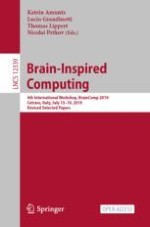Open Access 2021 | Open Access | Buch

Brain-Inspired Computing
4th International Workshop, BrainComp 2019, Cetraro, Italy, July 15–19, 2019, Revised Selected Papers
herausgegeben von: Prof. Dr. Katrin Amunts, Lucio Grandinetti, Thomas Lippert, Nicolai Petkov
Verlag: Springer International Publishing
Buchreihe : Lecture Notes in Computer Science